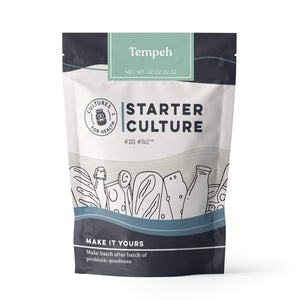
Tempeh is a traditional Indonesian food made by fermenting soybeans with a starter culture. Traditional tempeh has a rich smoky flavor and aroma with a firm, nutty texture. It is a great source of protein and vitamin B-12.
2 hours
50 hours
2 lbs.
INGREDIENTS AND EQUIPMENT AVAILABLE AT CULTURES FOR HEALTH
Tempeh Starter Culture

Tempeh Starter Culture
$19.99
Tempeh starter will help you create traditional tempeh, a plant-based probiotic protein, usually made from soy. It is similar to tofu, but many people prefer tempeh due to its probiotics and higher content of protein, fiber and vitamins.
It is a great meat alternativeand can be sliced, marinated, or seasoned as desired.
With our tempeh starter culture spores,you can make a supply of rich, nutty tempeh in the traditional Indonesian way!
TIPS FOR MAKING TEMPEH
- It's not unusual for there to be a bit of a learning curve when making tempeh. If your first batch doesn't turn out, just try again.
- Use a thermometer to verify the ongoing temperature of the tempeh during fermentation. (A meat thermometer with an alarm often sold for baking and for the BBQ are very useful as they will warn you if the temperature falls outside a set range.) When taking temperature readings, be sure to insert the thermometer directly into the beans, rather than testing the temperature near the beans.
- If you wish to freeze the finished tempeh, steam the tempeh over boiling water for 20 minutes to cook then slice into patties and soak overnight in salt water (2 teaspoons salt to one pint water). The patties can then be patted, dried, and frozen for future use.

INGREDIENTS:
- 2 cups dry soy beans, hulled
- 2 Tbsp. vinegar
- 3/4 tsp. (1 packet) Tempeh Starter Culture
INSTRUCTIONS:
-
Boil the soybeans for 1 hour to cook.
-
Discard the cooking water and dry the beans (either using a towel to pat them dry or setting over low heat in the pot to evaporate the water off the beans). It is important for the beans to be dry to the touch, as too much moisture can ruin the batch.
-
Place the beans in a dry bowl and allow the beans to cool to a lukewarm temperature (same temperature as your skin).
-
Add the vinegar and mix well.
-
Add the tempeh starter and mix well to evenly distribute the starter in the beans.

-
Place the beans in two vented containers (or quart-size plastic bags with needle-size holes poked through at 1/2-inch intervals). The beans should be layered 1 to 1-1/2 inches thick.
-
Incubate the beans at 85-91°F for 24 to 48 hours. For ideas, see our article on Incubating Tempeh. Verify the temperature using a thermometer inserted into the beans, rather than testing the temperature next to them.
-
Check the beans after 12 hours. At this point in the process the fermentation will cause the beans to generate their own heat so you will normally need to reduce or even eliminate the external heat source. Be sure to use a thermometer to check the actual temperature.
-
After 24 hours or so, the white mycelium will start to cover the surface of the beans. Over the next few hours the white mycelium will grow through the beans and will smell nutty.

-
After 24 to 48 hours, when the beans have become a single mass held together by the white spores, the tempeh can be refrigerated.














